Best bass effects pedals 2025: 11 of the best pedals for every type of bassist
Our guide to the finest sounding effects pedals for bass players, including fuzz, compressors and multi-effects
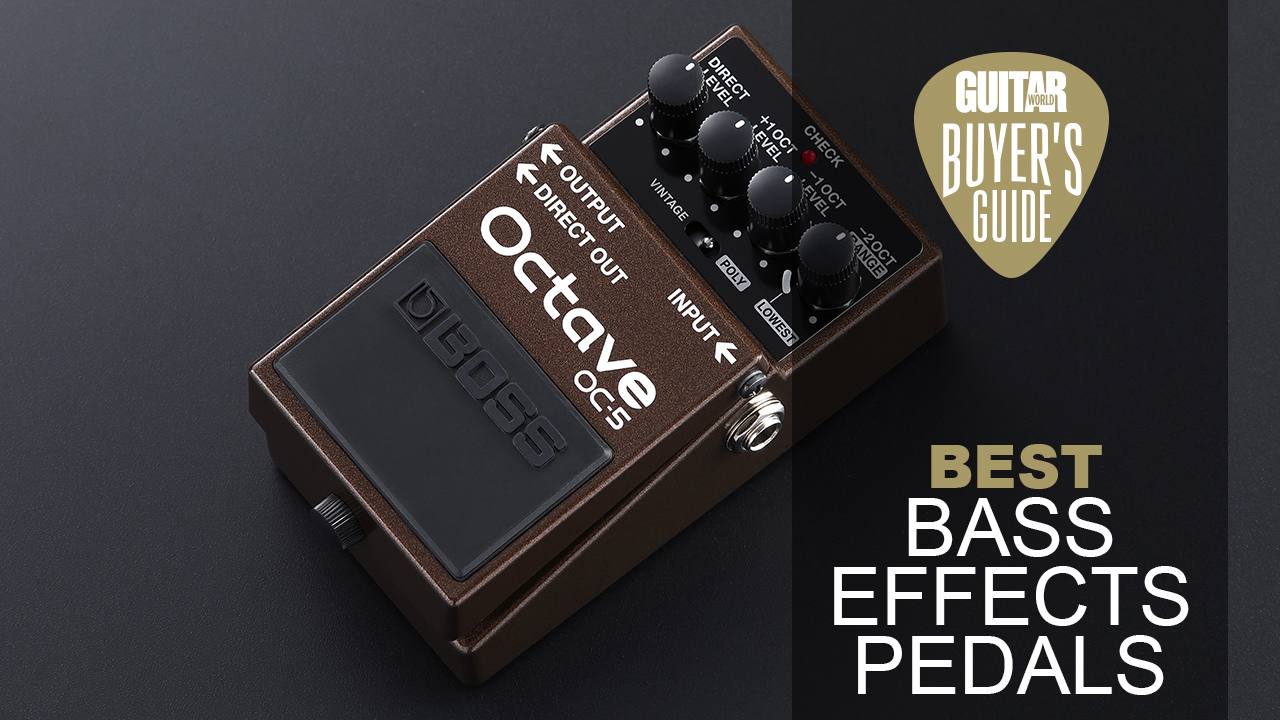
Ensure that the guitarists in your band don’t have all the fun by equipping yourself with some of the best bass effects pedals. For years, the market has been heavily weighted toward six-string pedals, but the bass world is catching up. From fuzz and overdrive to modulation and beyond, there’s now a plethora of options to choose from, which is why we’ve made this guide to the finest effects pedals for bass on offer right now.
The best bass pedals can be used in lots of different ways, too. Sure, they’re great for introducing some extreme and wacky sounds, but they can also provide subtle enhancements to your existing tone. Whether it’s a touch of vintage grit or aggressive, gnarly fuzz, the best bass effects pedals offer it all.
It’s hard to think of any type of player that wouldn’t benefit from a few choice pedals, too. Regardless of the genre you play, there are a bunch of pedals out there that will liven up your tone and get you thinking about the instrument in a slightly different way.
Our top picks
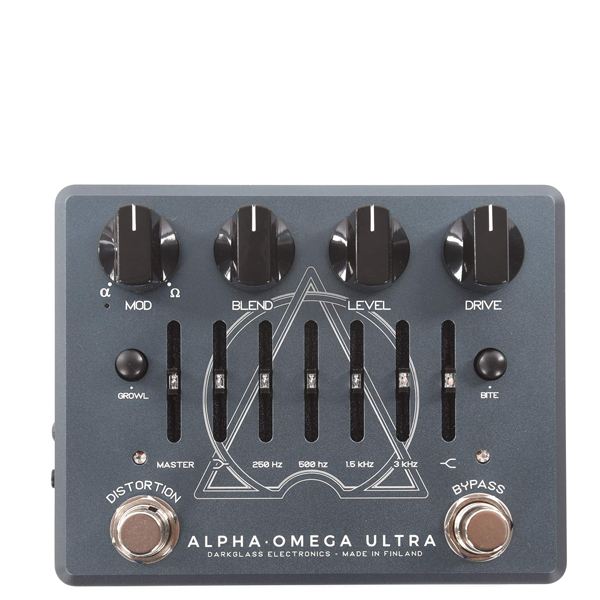
The Darkglass Alpha Omega Ultra V2 is capable enough to replace your entire rig with a small box you can fit in your pocket or guitar case. Primarily it's a pre-amp loaded with gorgeously saturated overdrive and rich fuzz. Add to that a 6-band EQ, XLR out, aux in, and headphone socket, and Darkglass has provided us with a small, neat, wonderful-sounding solution for both practice and gigging.
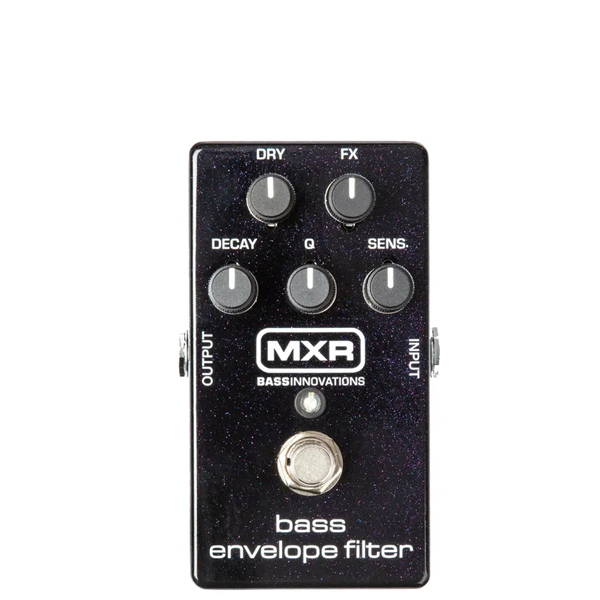
For a fun effect you'll never tire of, go buy yourself an MXR M 82 Bass Envelope Filter. It's like the clever techs at MXR have captured the world's funkiest bass sounds and crammed them all into one tiny pedal. Plug in your bass and listen to them pour out in one long, thick stream of funky goodness.
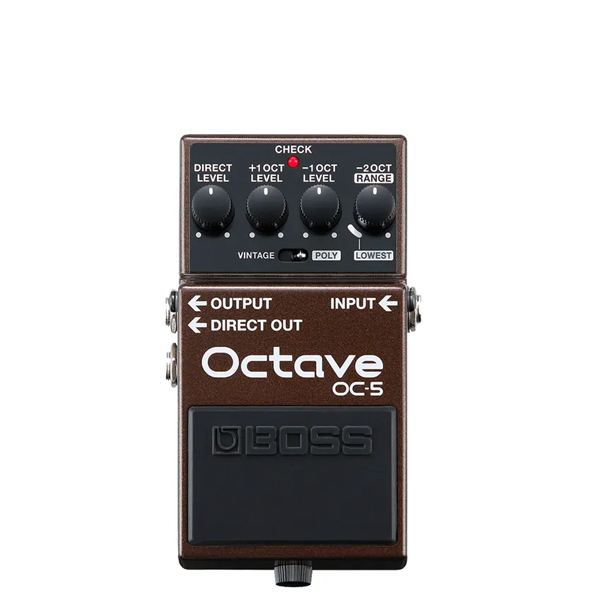
When it was introduced way back in 1982, the original Boss OC-2 Octave was adored by bass players as a simple solution to thicken up their sound. One octave below and two octaves below were the only options, but it did the trick, and the analog circuit sounded gorgeous. The modern variant, the OC-5, continues this legacy with super-fast tracking and a rock-solid build.
Best overall
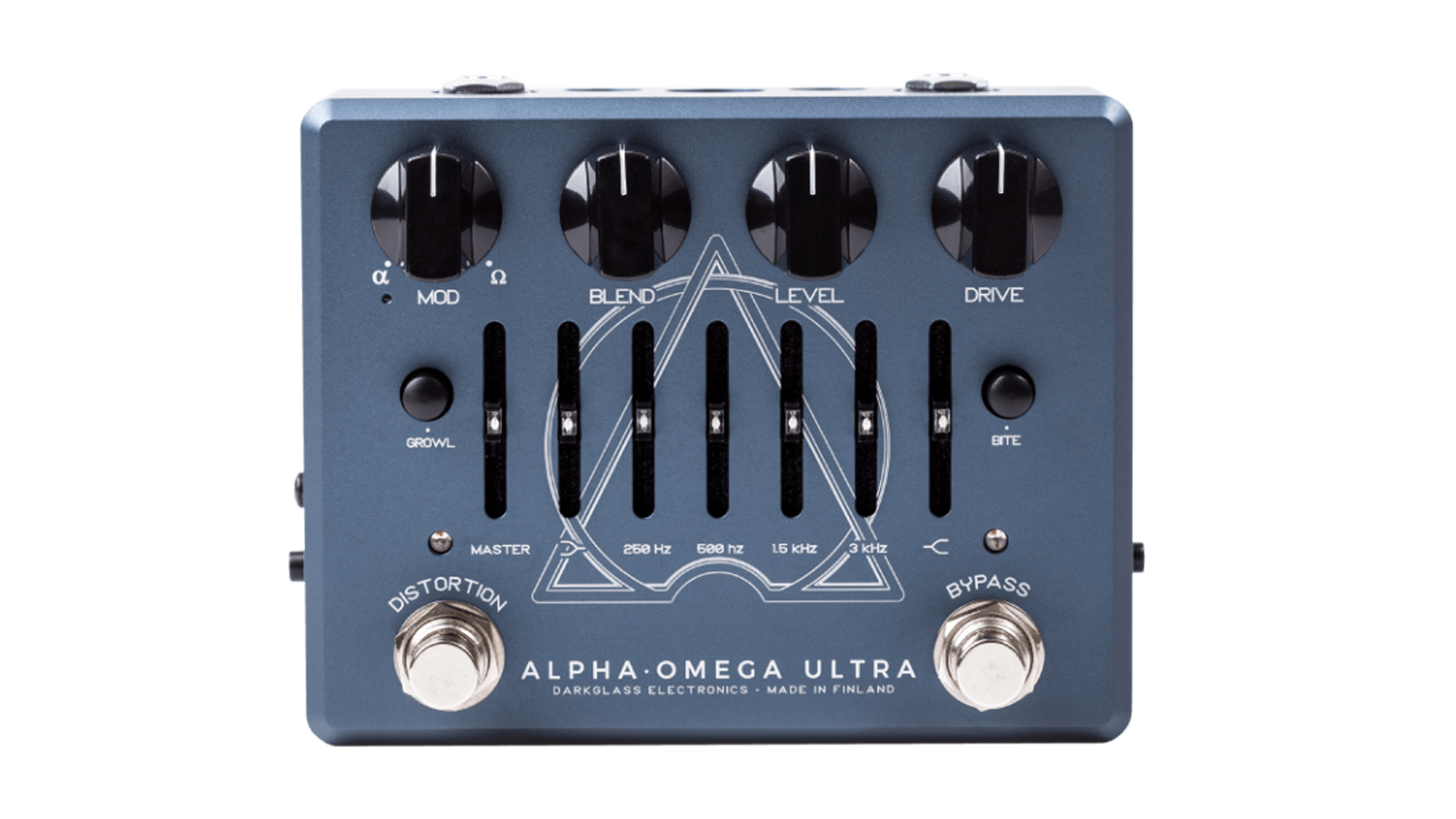
1. Darkglass Alpha Omega Ultra v2
Our expert review:
Specifications
Reasons to buy
Reasons to avoid
If you want to go amp-less, and distortion is your weapon of choice, then the Alpha Omega Ultra could replace your entire rig. Darkglass is known for two things – high quality and high gain tones – and the Alpha Omega Ultra fulfils both expectations in a pocket-sized package.
Most visually noticeable is the six-band EQ on the top panel. There are actually seven faders but the first is a master volume control that, not surprisingly but slightly frustratingly, doesn't work in bypass mode. So, watch the dry volume when you're wearing headphones and hit the bypass footswitch.
On to the real meat of the pedal. Spin the Mod knob to the left and you'll be soaked in a warm sea of saturated overdrive. Turn it clockwise and that overdrive gradually turns to bags of fuzzy goodness. You can blend away to your heart's content, discovering your own distortion-rich sweet spots.
Use the Blend knob to mix the driven and dry signal, the Level knob to set the overall volume of the driven signal and the Drive knob to ramp up the gain. Bring the EQ faders into play and you'll have complete mastery of your tone. Additionally, the rather cutely named Growl button will boost the bass for a fatter tone, while the Bite button will boost the mids for more definition.
You can plug your phone, or other audio source, into the Aux socket and don your headphones for a superbly versatile practice rig. Hook up a PA via the XLR out, enable the cab simulation and you've got the perfect live rig. A wide and growing choice of excellent impulse response cab sims can be swapped in and out via the USB port using Darkglass Suite software.
The only downside we can think of is that in a live situation you'll be putting the Alpha Omega Ultra at the end of your effects chain to take advantage of those cab sims. However, if you're into time-based effects, which usually come last, you'll have to rethink your signal flow. It's not a deal breaker, but worth knowing about.
Best envelope filter

2. MXR M82 Bass Envelope Filter
Our expert review:
Specifications
Reasons to buy
Reasons to avoid
Get on down y'all! If this pedal doesn't make you want to move your funky junk nothing will!
It's almost impossible to dial a bad sound into the MXR Bass Envelope Filter, there's so much good stuff bubbling under just waiting to be unleashed. From thick quacky duck-like sounds to thick syrupy quacky duck-like sounds with extra helpings of luscious goo, it doesn't disappoint. To be fair, it's a bit more versatile than that but most players will be using it for its dripping wet funk tones. Play around with the settings and you can also find synth-type sounds plus the more obvious wah and cocked-wah tones.
There are a few knobs to get your head around but it's actually a pretty easy pedal to use. MXR has been kind enough to give us separate Dry and FX controls, and these are absolutely key to shaping the sound you're looking for. If the wet signal is sounding good but you're losing depth and definition then just mix some of the dry signal back in to regain thickness and clarity.
The Decay and Q controls are integral to shaping your envelope. Decay controls the decay of the envelope sweep, so wind it anticlockwise for those fast quacky sounds we all love so much and clockwise for slower, more subtle effects. Q controls the peak resonance or intensity of the effect. The Sens. knob increases the envelope filter's sensitivity to your notes' attack as you spin it clockwise.
It sounds complicated but you'll get the hang of this pedal in no time. This is one fun effect that you'll never tire of.
Best octave

Specifications
Reasons to buy
Reasons to avoid
When it was introduced way back in 1982 the original Boss OC-2 Octave was adored by bass players as a simple solution to thicken up their sound. One octave below and two octaves below were the only options, but it did the trick and the analog circuit sounded gorgeous. You could coax synth-like sounds from it too, which, surprise, surprise, were popular back then. Vintage Japanese-made units still fetch high prices today.
The subsequent OC-3 added polyphony, but purists claimed that its digital circuitry never sounded as good as the original. Then, last year Boss announced the OC-5, which brings new features and retains the original OC-2 sound.
There are now two modes: vintage and poly. Vintage, as you've probably guessed, works just like the OC-2 and sounds every bit as good. As before, you can thicken your dry bass sound with a doubled signal that's one octave below, two octaves below or both. Additionally, you now have the option to bring in an octave above for a truly massive sound. Or you can dial out your dry sound completely for those creative faux-synth tones.
Poly mode works in a similar fashion but, as the name suggests, enables you to play chords. The range knob restricts octave doubling to the lower bass notes, retaining clarity in the higher registers – possibly more useful for guitar than bass.
Tracking is superfast, it's almost impossible to play too far ahead of the OC-5.
As you can imagine, turning everything to 11 sounds fun for a few minutes but it soon becomes tiresome. Instead, spend some time experimenting with the more subtle settings and the OC-5 reveals some very interesting yet usable sounds.
Whether you use the OC-5 as a thickening agent, or as a gateway to a whole new sonic palette of sounds, it's worthy of a place on your pedalboard.
Read the full Boss OC-5 Octave review
Best budget all-in-one
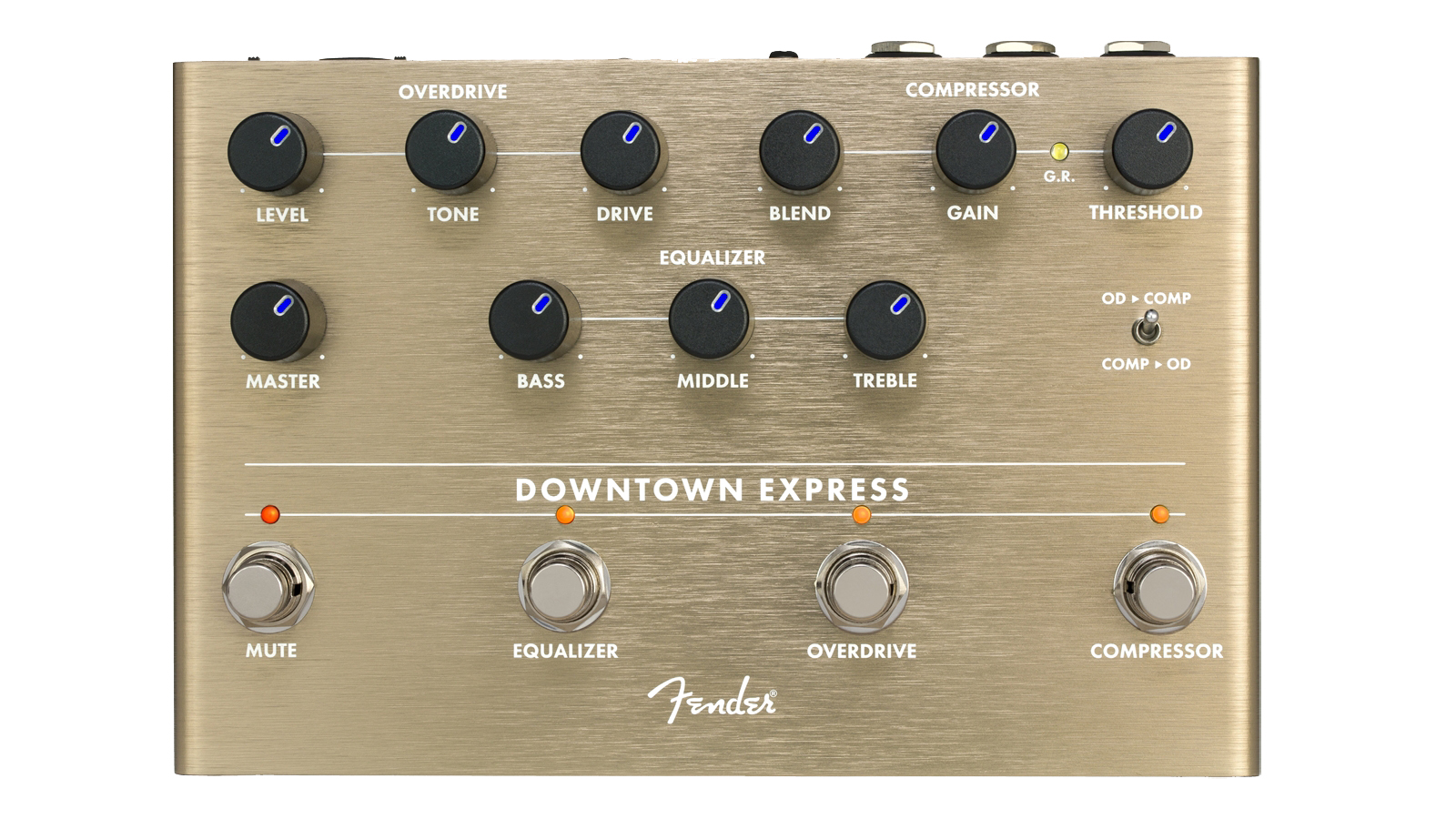
4. Fender Downtown Express
Our expert review:
Specifications
Reasons to buy
Reasons to avoid
Fender enlisted the help of bass amp and pedal luminary Alex Aguilar, formerly of Aguilar Amplification, to help develop the Downtown Express. So, this pedal may be relatively new, but it's got heritage. It's also got an alluring price tag.
The Downtown Express brings together three key effects in one neat, affordable solution: overdrive, compression and EQ.
The overdrive is voiced to go from subtle to driven like a diesel truck. Apparently, Alex spent a lot of time designing in a custom bass cab simulator that preserved the low end while removing the fizz from the more extreme tones.
The RMS compressor is typically subtle, natural and transparent. A Gain knob is there to bring back some volume if compression makes your sound a little too quiet, and there's also a Blend knob to re-introduce your dry signal. This is useful if you want to retain some of your attack sound.
The three band EQ – Bass, Middle, Treble – is pretty self-explanatory, allowing you to compensate for boominess in the lows and scoop/boost the mids to help you cut through a mix. Scooping the mids on the Downtown Express can also yield a fantastic slap tone.
This pedal goes above and beyond with a few additional features that shows Alex and his team at Fender wanted to deliver something they could be proud of. There's an Order toggle switch that enables you to place the overdrive before the compressor and vice versa, depending on your sonic intentions. Additionally, your DI'd signal can include the overdriven signal, the drive and the EQ, or can be completely dry.
This is useful when using your amp as a monitor in combination with a PA for live amplification. Your wet amp signal can include the effects, but the dry DI'd signal can be EQ'd at the desk to better suit the house PA.
Finally, even the knobs are LED backlit to make them easier to see under murky stage lighting. This is a fantastic effort from Fender.
Best fuzz
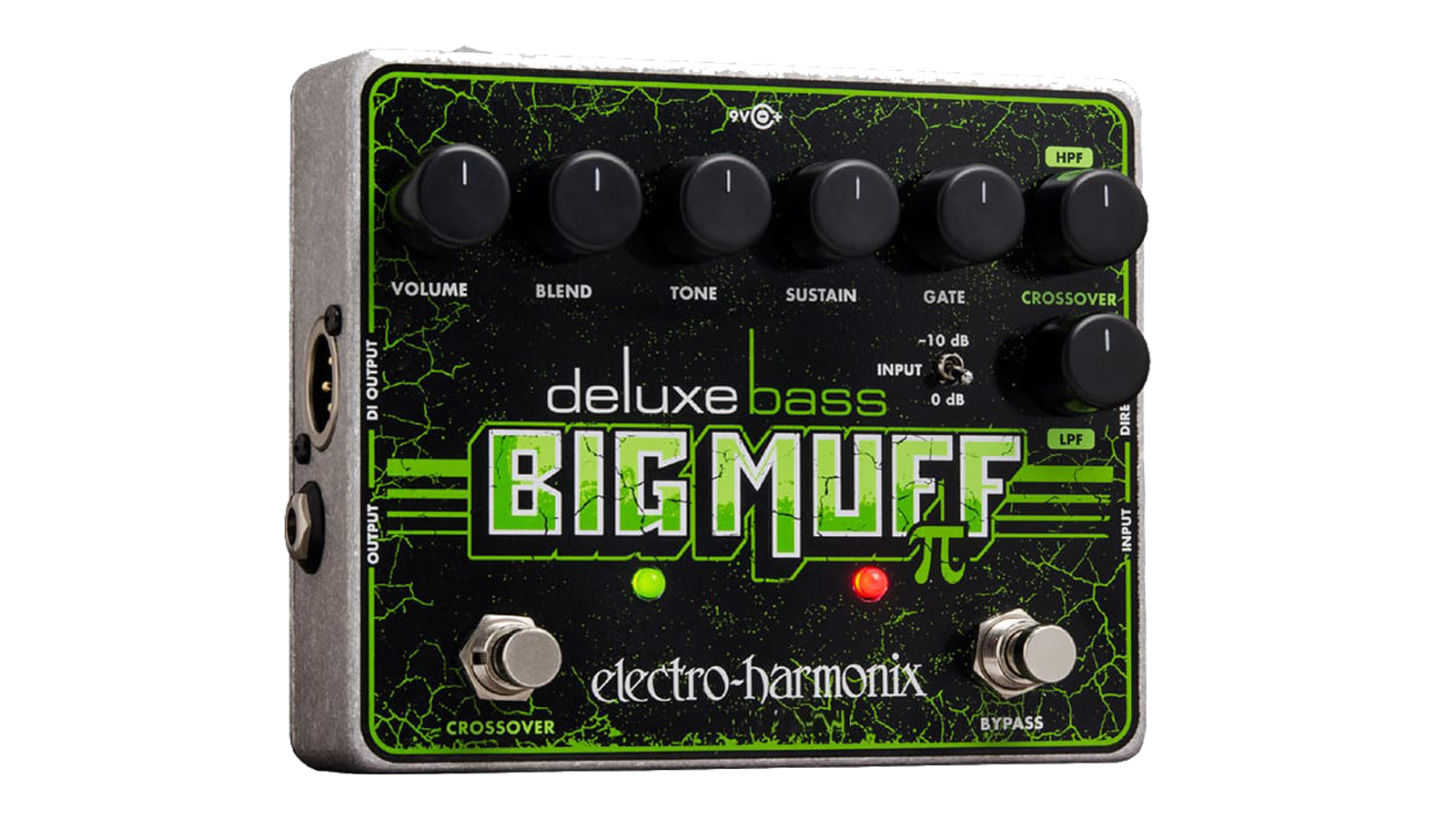
5. Electro-Harmonix Deluxe Bass Big Muff Pi
Our expert review:
Specifications
Reasons to buy
Reasons to avoid
If oodles of smooth fuzz is your thing, the Big Muff Pi delivers by the container load. Originally developed for guitarists, it was a favorite of Hendrix, Gilmour, Santana – in fact pretty much everyone back in the '70s.
Unusually, for such an iconic pedal, it was late to the party, left early, then returned after a change of outfit. Fuzz had been popular since the early sixties, but the Big Muff Pi wasn't brought to market until the early 1970s, when it became an instant hit.
New York-based Electro-Harmonix founder Mike Matthews was declared bankrupt in the early '80s but by the '90s he'd started manufacturing an overhauled version of the Big Muff in Russia under the Sovtek name. Allegedly from old Soviet tank parts!
It's true that most Russian Muffs were painted battle tank green, made in a decommissioned Soviet military factory that was headed up by a couple of ex-colonels (you couldn't make it up – worth a Google), but there's no reliable evidence that they featured weapons parts.
What is certain is that bass players absolutely loved these revised Russian Muffs. More by accident than design, their smooth, low gain distortion complemented the bass frequencies beautifully.
By the 2000s, production had moved back to the USA and a new Big Muff Pi was developed to sound more like the original '70s version. Nonetheless, it didn't take long for Electro-Harmonix to recall that bass players preferred the Russian sound, and in 2008 it re-issued what was essentially the Sovtek design as the Bass Big Muff Pi.
Of course, Mathews and his team couldn't resist tinkering some more, introducing the much-enhanced Deluxe Bass Big Muff Pi in 2013. They added numerous useful features to what is, let's face it, a very basic pedal, hugely expanding its capabilities.
A foot-switchable 'crossover' section adds a variable low pass filter on the dry signal and a high pass filter on the distorted signal. This is really useful for sound shaping – creating some low-end punch, for example – and enables you to quickly dial in a cocked wah pedal tone or even something more 'out there'.
The Blend knob lets you mix the dry and distorted signals to taste, helping you to enhance your tone with a subtle amount of fuzz, or mountains of it. Meanwhile, the built-in adjustable noise gate tames any hissy fits.
Finally, the Deluxe Bass Big Muff Pi includes a -10dB pad for active pickups, and three outputs including a ¼" effect out, an XLR DI effect out plus a ¼" dry out, which is useful if you ever need to isolate your bass guitar's dry signal.
The remarkable thing about the Deluxe model is that it barely costs much more than the standard bass pedal. This is the one to go for.
Best mini compressor
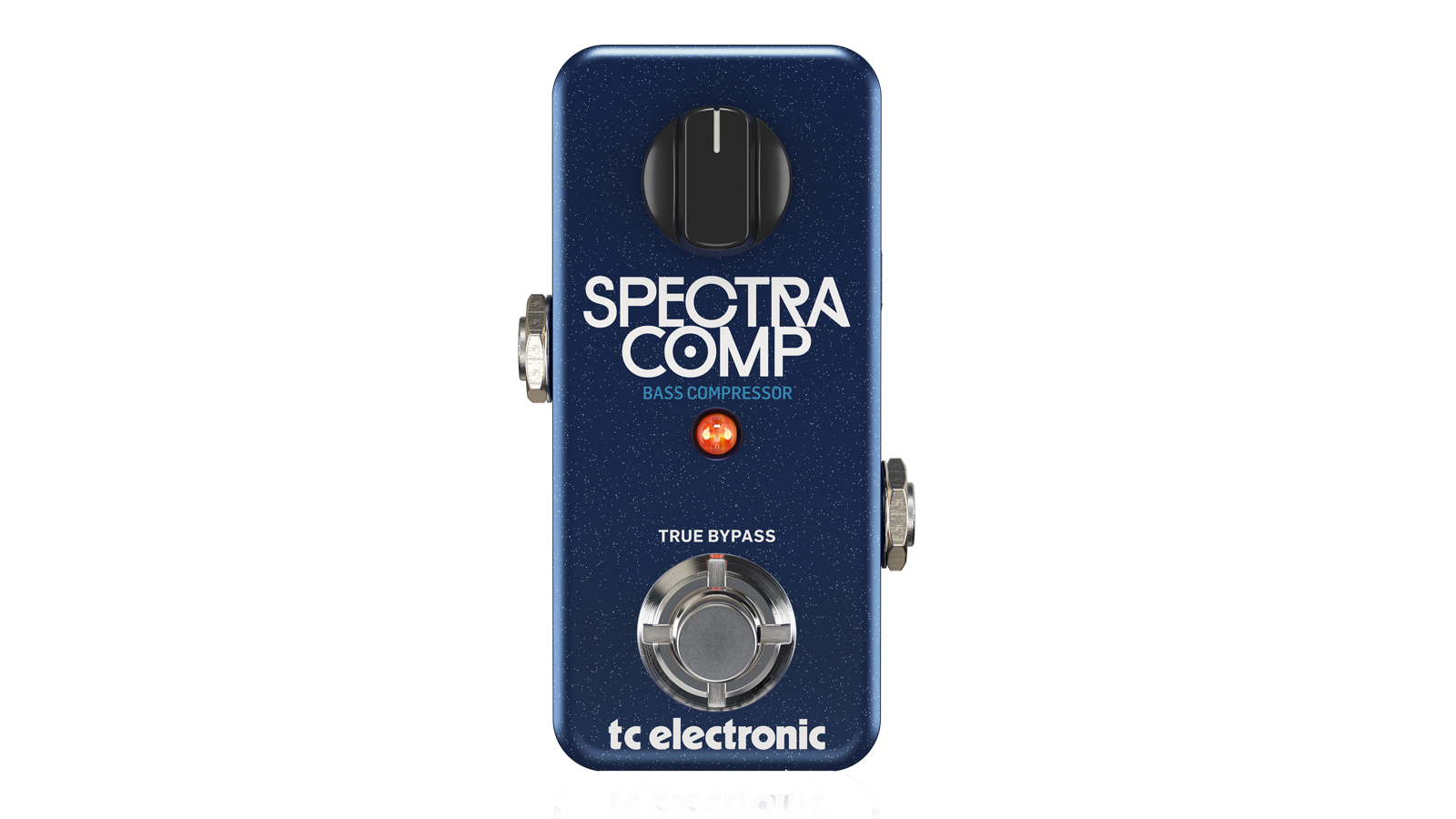
6. TC Electronic SpectraComp Bass Compressor
Our expert review:
Specifications
Reasons to buy
Reasons to avoid
This thing is tiny. As you can probably guess, from its uncluttered top panel, it's also a breeze to use but don't judge it by its single control knob. This is a bass compressor pedal that can be as simple or complex as you like.
Let's do simple first. Plug it in. Dial it in. That's really all there is to it. As you twist the knob the Spectracomp is doing all sorts of calculations behind the scenes to give you a smooth, balanced tone. For example, a compressor usually has at least one other knob to adjust your signal level. That's because your signal often has to be boosted in order to compensate for the compression, or everything just gets a bit too quiet. Operating the two knobs is always a bit of a juggling act that takes patience and skill that not all of us have or possess.
With the Spectracomp you don't have to worry, it automatically adjusts the level as you dial in more compression. It's also a multiband compressor that uses the same compression engine as TC Electronics high-end System 6000, which means that it adjusts the highs, mids and lows individually for a balanced output. This has the effect of taming the low end while keeping your sparkly high harmonics intact.
Now for the complex. The Spectracomp is TonePrint enabled, so if you're not getting along with the default compression algorithm you can download another to your phone from TC Electronic's TonePrint library and beam it to the pedal. The choice is extensive, with hundreds of TonePrints available, listed by artist or playing style.
Still not enough? Then get stuck into TC Electronic's editor and create your own TonePrint by adjusting scores of parameters to suit your individual tastes.
In short, if you want something that just works the SpectraComp makes compression as easy as spinning a knob. If you're the nerdy type who enjoys tweaking every parameter then you'll be in seventh heaven too.
Best multi-effects
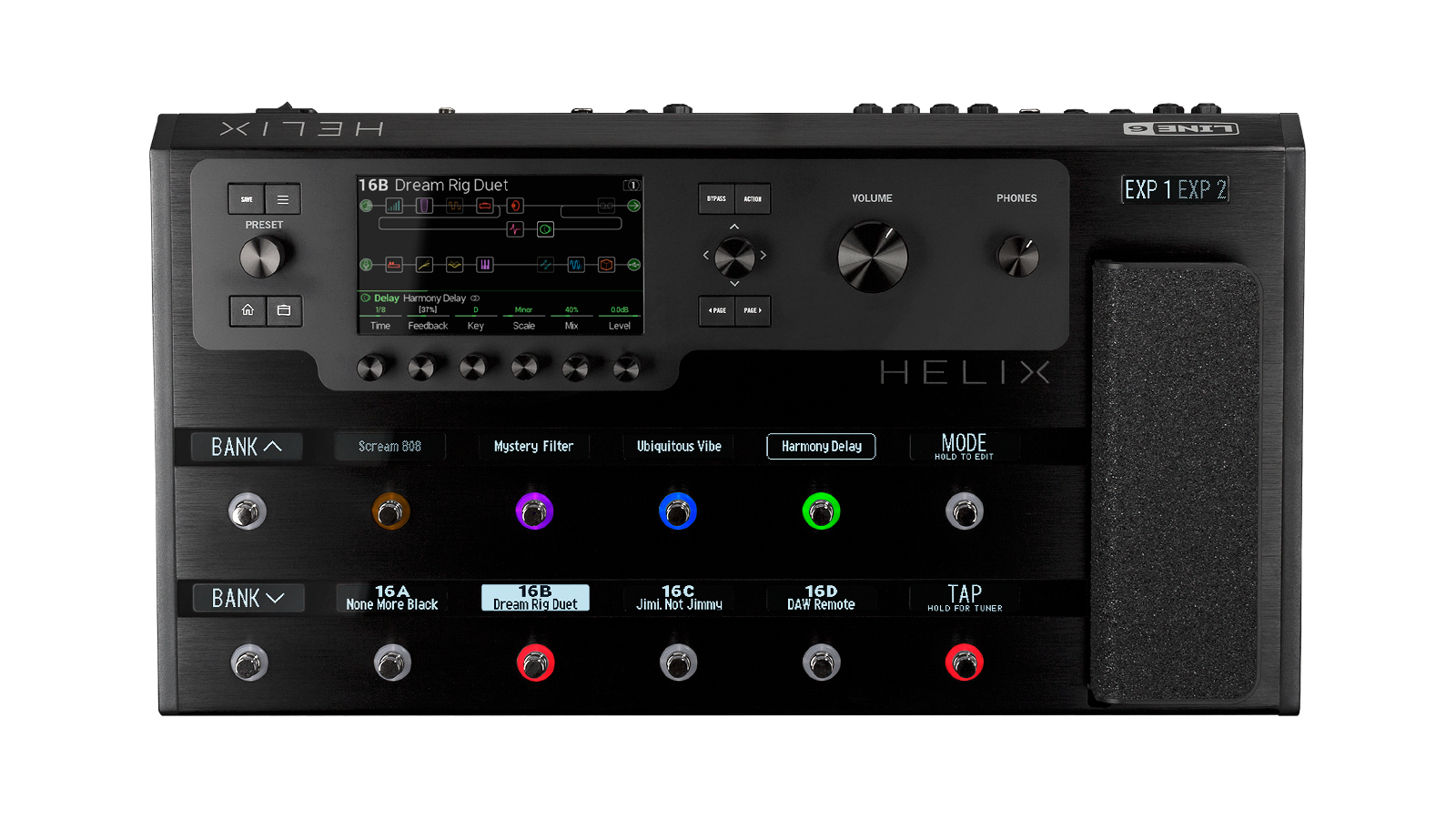
7. Line 6 Helix Guitar Processor
Our expert review:
Specifications
Reasons to buy
Reasons to avoid
Where to start? The Helix Guitar Processor is a complete rig for the guitarist, bass player, singer. Heck, even if you already own a rig then it can act as a controller for it.
Today you get 50 guitar amp models, 12 bass amp models, 37 cab sims, 16 microphones and 104 effects. Tomorrow? Who knows? Line 6 regularly adds more functionality with every firmware release.
When Line 6 launched its red, kidney-shaped Pod back in the late 1990s most of the modelled sounds were uncannily authentic. The rest were, er, a bit questionable. These days, thanks to competition from the likes of Kemper, Fractal, Boss, Blackstar and so on, the quality is just superb.
Signal routing is another Helix strength. It's so easy to experiment with complex signal paths that would be next to impossible to create in the 'physical' world. Talking of real stuff, the Helix is equipped with four effects loops, a mic in, MIDI, three expression pedal sockets and CV, making it's easy to utilise your legacy hardware. In many ways it's as much a recording interface as it is an amp and effects modeller.
It's even possible to individually route and play multiple instruments through the Helix at the same time, which may help you and your bandmates justify the cost. If you're a multi-instrumentalist singer-songwriter, so much the better!
It's an undeniably amazing tool, but the first noise you'll hear when you clap your eyes on a Helix is a sharp intake of breath. Yes, the price.
Still, think about how much time you spend gigging or in the studio, then consider how much power and flexibility the Helix offers. It's actually remarkably good value.
Best chorus
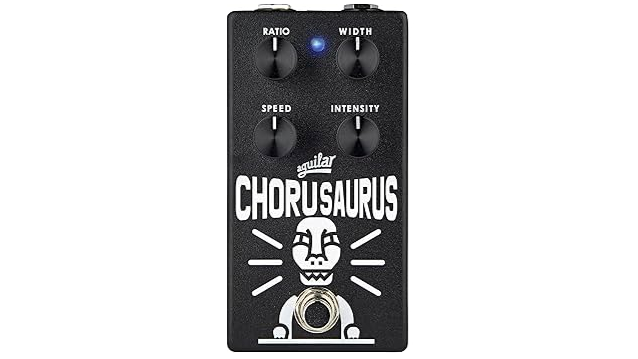
8. Aguilar Chorusaurus
Our expert review:
Specifications
Reasons to buy
Reasons to avoid
Despite the slightly comical Flintstone-esque name (well, we found it funny) the Chorusaurus V2 is a seriously good bit of kit. This second iteration of the Chorusaurus features an all-new graphic design and lighter enclosure but retains the warmth and thickening qualities that made the original one of our favorites.
To achieve such warm chorus tones, Aguilar intentionally uses what some might consider outdated or flawed analog bucket brigade technology to create the Chorusaurus' rich, warm, and smooth chorusing effect.
Operation is simple. The Blend knob controls the mix between the dry and wet signals. Chorus works by mixing the dry signal with a duplicated, variably delayed wet signal, and the tempo of that modulation is controlled by the Rate knob. The Intensity knob controls the intensity of the modulation, so increasing it produces ever more dramatic effects. Finally, the Width control sets the range for the intensity to work within. Broadening the range enables a more intense effect.
For slow, melodic playing, reduce the Rate control, and for faster staccato styles, experiment by speeding it up. Vary the other controls until you find what you're looking for. It's not obvious, but stereo output is possible if you use a Y-Cable.
Aguilar specializes in making quality, dare we say expensive, bass amps and effects, so it's no surprise that this pedal's premium-sounding tone comes with a premium price tag. Nevertheless, it's a lovely effect that's exemplified by this ped
Best budget EQ

9. Behringer BEQ700 Dynamics/Equalizer Pedal
Our expert review:
Specifications
Reasons to buy
Reasons to avoid
An EQ pedal may not seem like a particularly exciting option to add to your pedalboard, but it shouldn’t be underestimated how useful they can be, either for surgically altering your sound to remove unwanted frequencies, or as a boost pedal for killer bass moments.
The Behringer BEQ700 is the perfect partner for this, with seven graphic sliders allowing you to cut or boost specific frequencies by up to 15dB as well as a master level control to adjust the overall sound to your ideal volume.
Each band has a predetermined width – unlike parametric EQs where specific frequencies can be widened or narrowed – which for some won’t be to their taste, but in general the chosen bands are perfect for most uses. Though a guitar EQ pedal would still be usable with bass, this is an instance where having a specific bass guitar version is much more valuable, as the frequency bands are fine-tuned for bass and go all the way down to 50Hz – the standard Behringer EQ700 (for guitar) only goes down as far as 100Hz. More expensive Bass EQ pedals are available, but it’s hard to justify buying them when the BEQ700 is so effective.
Best portable rig
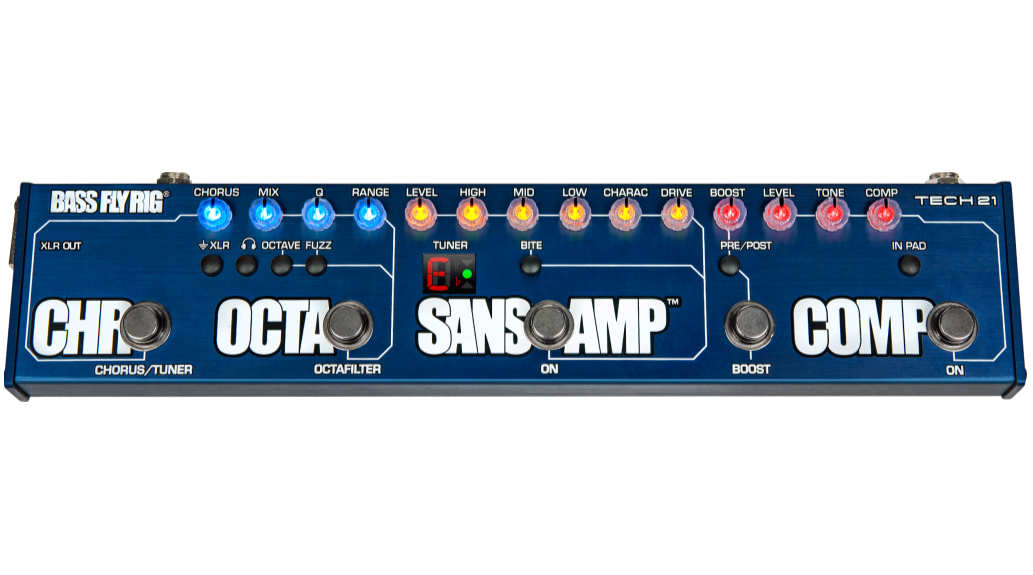
10. Tech 21 Bass Fly Rig v2
Our expert review:
Specifications
Reasons to buy
Reasons to avoid
As creators of the legendary SansAmp bass preamp, Tech 21 certainly knows a thing or two about making great bass pedals, and that continues with the Bass Fly Rig v2, a sleek multi-effects unit with just about everything you need to craft superb, effects-laden bass tones. It features two switchable SansAmp channels, plus EQ, compressor, octa filter, fuzz, chorus, tuner, and even an effects loop, which is an addition from the v1 version.
At only 12.5” wide, it’s still compact enough to fit into a rucksack – which can’t always be said for bass multi-effects units – so would be a perfect traveling partner for a gigging bassist who is looking to condense their rig size, particularly as the Bass Fly Rig can be plugged directly into the PA through its DI output, which features cab sim.
It may not have quite the level of pro-grade effects that every player will be looking for, however the casual bassist who is looking to add a host of different effects to their rig will find this an elegant solution.
Best tone shaper

11. Origin Effects DCX Bass Studio
Our expert review:
Specifications
Reasons to buy
Reasons to avoid
If you’re looking for the best bass pedal to tweak and enhance your tone, then this compact offering from renowned pedal makers Origin Effects could well be the one.
It’s technically a preamp pedal and is inspired by the legendary Universal Audio 610 unit. You’ve got an EQ mode, where the pedal serves as a more tonally neutral, lower gain pedal and then an OD mode, where things can get a little more extreme and you’ve got the ability to dial in fuzzy, cranked preamp sounds. The Voice switch gives you more control over the high end frequencies and ensures that you never get a harsh or fizzy sound even when the gain is set high.
The HF and LF knobs have been voiced specifically for bass and allow for precise tone-sculpting whilst ensuring a smooth and warm sound. The pedal really easy to use, and it’s incredibly versatile, plus the build quality is absolutely second to none - definitely one of the best bass effects pedals out there.
FAQ
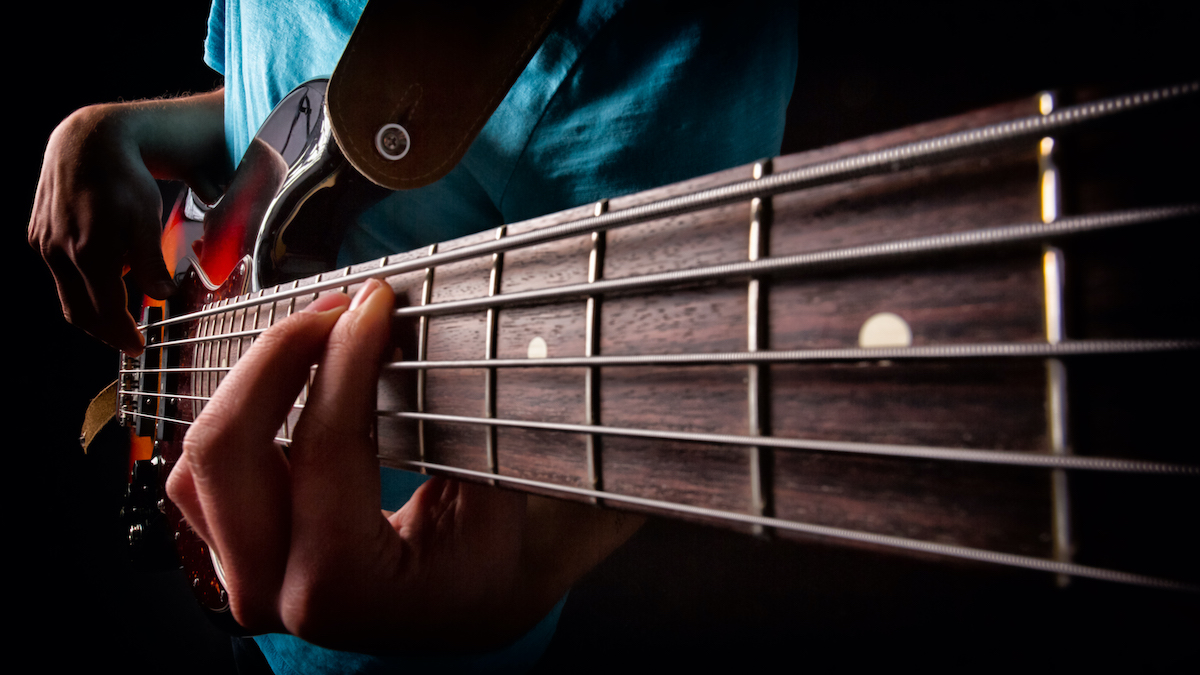
Do I really need bass effects pedals?
This is all dependent on the types of tone and style you play and, for some, pedals will be little more than another thing to distract from your playing. However, most players will find that the addition of one or two pedals can be really valuable and provide entirely new bass sounds.
If you are steadfast against buying pedals, many of the best bass amplifiers will come with some kind of effect or tone processing built in, be that a compressor, modulation, or simply some overdrive. If you are looking to avoid pedals, it may be wise to invest in an amplifier that has effects so you don’t need external pedals, though it is worth remembering that effects pedals have been made to do a specific job and you may achieve better results when using them compared to integrated amp effects.
Can I use guitar pedals with my bass?
As a general rule, most guitar pedals will work with bass, though they may not be optimized for bass as it sits in a different frequency range to guitar. The best demonstration of that would be a bass EQ pedal. When put next to a guitar EQ you will see that different frequency bands have been chosen as they work better for their respective instruments.
This can also be noticed in some guitar distortion and modulation effects, which really aren't voiced correctly for low bass frequencies and are best avoided. Often, if a brand has a particularly popular guitar pedal it will also develop a bass-voiced version – a good example of this is the Electro-Harmonix Bass Big Muff Pi. Some pedals, such as the Boss OC-5 Octave, have a switch you can throw that adjusts the voicing for guitar or bass. If you have any guitar pedals lying around, it’s always worth experimenting with them on your bass!
Which effects are an absolute must for bass?
You can trust Guitar World
There are lots of different effects out there for bass; some you might want to have on all the time, and others might just be kicked in for a few seconds in your live set to make a big sonic statement. Let’s look at some of the main effects for bass.
Overdrive/distortion/fuzz: There are differences between overdrive, fuzz, and distortion, but they can all loosely describe adding grit or dirt to your sound. Technically speaking, all three effects add clipping to the waveform, albeit in different ways. Any one of these can help thicken up your bass tone and make it sound heavier and generally angrier.
If you’re looking to make a small pedalboard for bass, chances are you’ll have one of these on there.
Modulation: Modulation pedals are popular for bass, too, particularly chorus. Modulation pedals include chorus, vibrato, flanger, vibe, and phaser, all of which can add a sense of movement to your sound. They’re great for adding a bit (or a lot) of texture and can work well when other instruments drop out of a track and the bass is just playing on its own.
Compression: Aside from a tuner, if you’re going to have just one pedal for bass, we’d probably recommend it be a compressor. Compressors do precisely what they say on the tin - they compress your signal, helping lower the dramatic peaks in volume and raise the quiet parts to make it all more even.
Whether you’re playing with a pick or your fingers, a compressor is a useful tool in making your bass tone smoother and more consistent and allowing it to sit well in a mix.
Octave: Bass players often like to combine another octave with what they’re playing, whether that’s the one above or below - or both. Octave pedals are a great way of making your bass sound much bigger and occupy more space in a mix.
Preamp: Again, these are self-explanatory. Preamp pedals act as the tone-shaping part of an amplifier and can give you a wildly different sound from just plugging straight in.
There are lots of different models around, but many of them have EQ options on there, as well as the ability to introduce some overdrive or distortion. Some might even be based on sought-after or vintage amplifiers, giving you that classic sound in a much smaller and portable package.
Envelope Filter: Filter pedals are a must-have for any funk player. Depending on the dynamics of your playing, the filter’s cutoff frequency will change, giving an almost vocal-like sound. They’re great if you want certain riffs to stand out or if you’re just after something that will catch the listener’s ear.
Single or multiple effects?
When on the hunt for the best bass effects pedals, you’ll come across both single and multi-effects units. Both are great, and you might find that a mixture of the two works well for you.
Multi-effects pedals come in all shapes and sizes; some will have dozens if not hundreds of different effects and allow you to preset a range of settings available for quick recall via menus and screens. Others might have a select few effects, all dialled in with simple knobs and buttons.
Single effect pedals might be better if you know what you want, and you want something quality. All the parameters will be laid out there in front of you, and you can easily see what you’re doing and quickly dial in the sound you want.

Which pedal goes where?
What's the best order to place my bass effects pedals in? Genuinely, it doesn't matter. Or, more accurately, it may matter but the order depends on the sound you are trying to achieve.
However, conventional wisdom dictates that your effects signal chain should be as follows: bass guitar, compressor, volume pedal, wah, distortion, chorus, tremolo, delay, reverb, amp.
This order is based on the logic that time-based effects such as delay and reverb work best at the end of the signal chain, which makes sense. Alternatively, if your amp (if you have one) has an effects loop you can place them there.
Our advice is to experiment until you've found the order that's right for you. In fact, that advice goes for this entire guide. It's fun trying to emulate your favourite bass player's tones but ultimately it's more rewarding to discover your own signature sound. You can only do this through practice and experimentation. Have fun!
How we choose
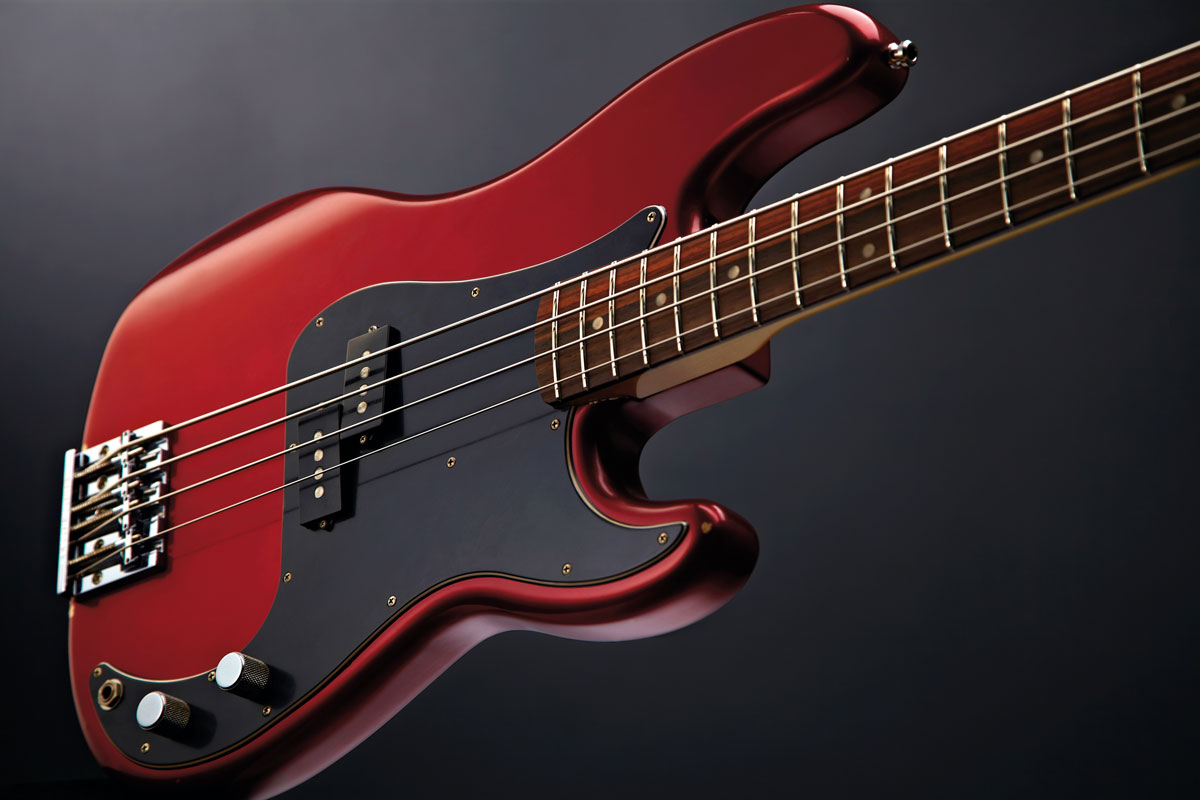
Here at Guitar World, we are experts in our field, with many years of playing and product testing between us. We live and breathe everything guitar related, and we draw on this knowledge and experience of using products in live, recording and rehearsal scenarios when selecting the products for our guides.
When choosing what we believe to be the best bass effects pedals available right now, we combine our hands-on experience, user reviews and testimonies and engage in lengthy discussions with our editorial colleagues to reach a consensus about the top products in any given category.
First and foremost, we are guitarists, and we want other players to find the right product for them. So we take into careful consideration everything from budget to feature set, ease of use and durability to come up with a list of what we can safely say are the best bass effects pedals on the market right now.
Read more about our rating system, how we choose the gear we feature, and exactly how we test each product.
Why trust us
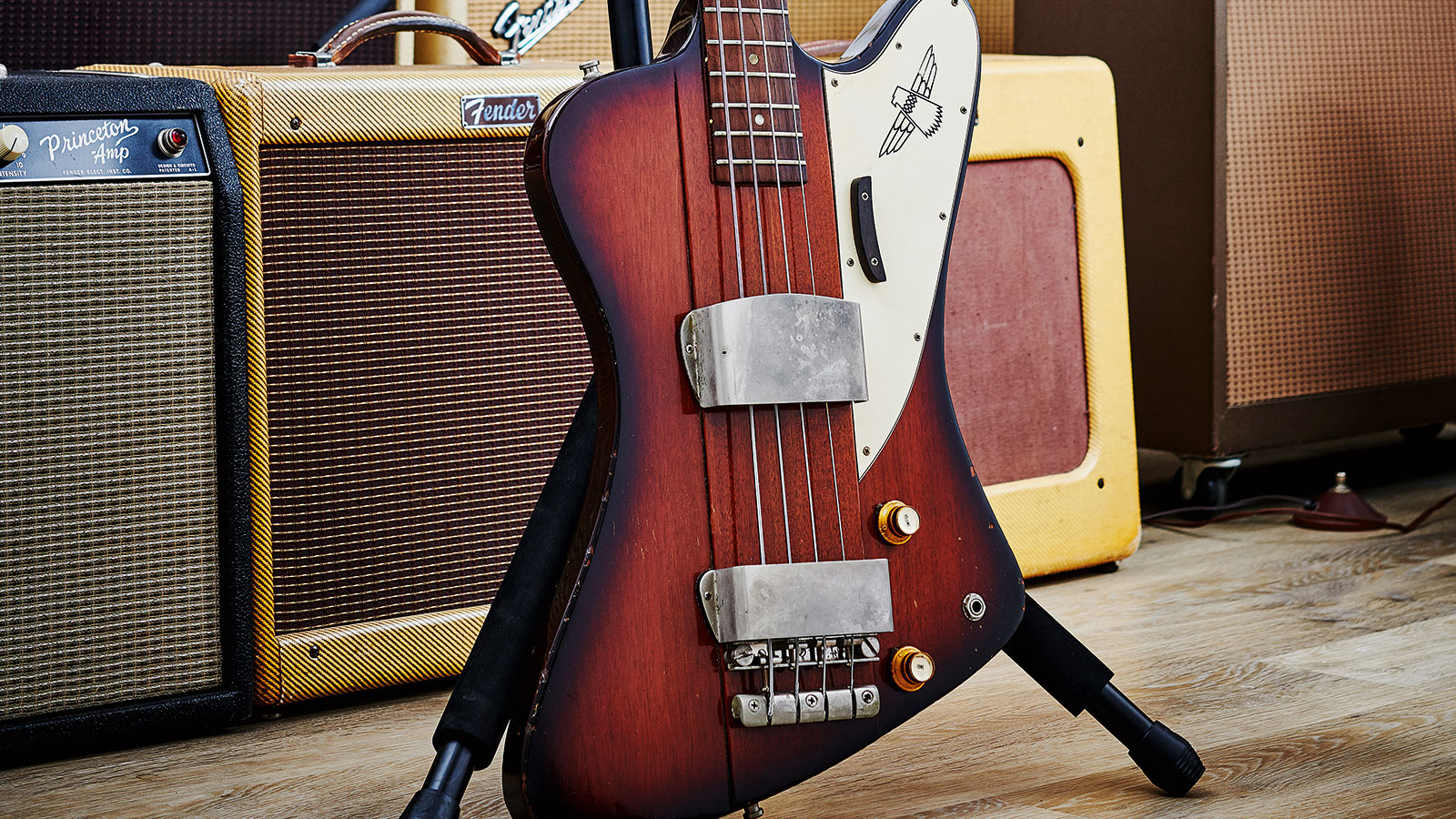
☑️ A global audience of 3.8 million guitarists monthly
☑️ 1,200+ reviews on GuitarWorld.com
☑️ 30+ years of product testing at Guitar World
Guitar World boasts over 44 years of expertise and stands as the ultimate authority on all things related to guitars. The magazine and website feature expertly written gear round-ups and top-quality, authoritative reviews penned by a team of highly experienced industry professionals.
Guitar World's inaugural print issue hit the shelves in July 1980, and ever since, it has been captivating players and enthusiasts with engaging lessons, insightful interviews with the biggest guitar heroes, and priceless buying advice for newbie players.
Furthermore, GuitarWorld.com continues this legacy online and serves as the hub of the world's foremost authorities on guitar playing. It is also the home of Bass Player Magazine. With a reach extending to 3.8 million players each month, GuitarWorld.com is a go-to destination for guitar fanatics globally.
Below, you'll find more information about the expert author of this guide.

When Simon's childhood classical guitar teacher boasted he 'enjoyed a challenge', the poor man had no idea how much he'd underestimated the scale of the task ahead. Despite Simon's lack of talent, the experience did spark a lifelong passion for music. His classical guitar was discarded for an electric, then a room full of electrics before Simon discovered the joys of keys. Against all odds, Simon somehow managed to blag a career as a fashion journalist, but he's now more suitably employed writing for Guitar World and MusicRadar. When not writing or playing, he can be found terrifying himself on his mountain bike.

After spending a decade in music retail, I’m now a freelance writer for Guitar World, MusicRadar, Guitar Player and Reverb, specialising in electric and acoustic guitars, bass, and almost anything else you can make a tune with. When my head’s not buried in the best of modern and vintage gear, I run a small company helping musicians with songwriting, production and performance, and I play bass in an alt-rock band.

Connor is a contributor to Guitar World and MusicRadar. Having been a guitarist since the age of 10, he's played bass and guitar in bands across the South West of England. He has a background in audio engineering, having worked in some of the UK’s best studios including Rockfield and Invada, and has a passion for recording guitar. He is always keen to discover the greatest gear for capturing tone, be that microphones, audio interfaces or cab simulators.
More related buyer's guides
- Freshen up with the best bass strings
- Thicken up your low end with the best distortion pedals for bass
- On a budget? Take a look at the best budget bass guitars
- Just getting started? These are the best beginner bass guitars
- Our pick of the best 5-string bass guitars
- Hone your chops with the best bass practice amps
- Here are our top picks for the best short-scale basses right now
- Best bass preamp pedals: consistently great tone on the go
Get The Pick Newsletter
All the latest guitar news, interviews, lessons, reviews, deals and more, direct to your inbox!
When Simon's childhood classical guitar teacher boasted he 'enjoyed a challenge', the poor man had no idea how much he'd underestimated the scale of the task ahead. Despite Simon's lack of talent, the experience did spark a lifelong passion for music. His classical guitar was discarded for an electric, then a room full of electrics before Simon discovered the joys of keys. Against all odds, Simon somehow managed to blag a career as a fashion journalist, but he's now more suitably employed writing for Guitar World and MusicRadar. When not writing or playing, he can be found terrifying himself on his mountain bike.










